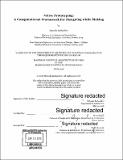| dc.contributor.advisor | Terry Knight. | en_US |
| dc.contributor.author | Bacharidou, Maroula | en_US |
| dc.contributor.other | Massachusetts Institute of Technology. Department of Architecture. | en_US |
| dc.date.accessioned | 2018-10-15T20:22:43Z | |
| dc.date.available | 2018-10-15T20:22:43Z | |
| dc.date.copyright | 2018 | en_US |
| dc.date.issued | 2018 | en_US |
| dc.identifier.uri | http://hdl.handle.net/1721.1/118501 | |
| dc.description | Thesis: S.M. in Architecture Studies, Massachusetts Institute of Technology, Department of Architecture, 2018. | en_US |
| dc.description | Cataloged from PDF version of thesis. | en_US |
| dc.description | Includes bibliographical references (pages 89-92). | en_US |
| dc.description.abstract | In the wake of an increased accessibility of rapid prototyping tools in design education and practice, designers still face a series of challenges related to their use, one of them being the way in which they use these machines to actively explore and enhance their ideas. At the same time, the concepts of continuous interaction with computational fabrication tools and design exploration through physical prototyping are gaining impetus in computational design research and human-computer interaction. Stimulated by these inquiries, the hypothesis of this thesis is that physical prototyping tools can be used as tools for active design exploration and evaluation. Towards this goal, I introduce Active Prototyping, a framework for enhancing physical engagement with design objects by aiding the designer to project the impact of tools on design outcomes and explore a range of possible design solutions while making. Active Prototyping integrates the following operations: (a) physical control of a fabrication device, (b) recording of designer actions while using the device (c) visual exploration of possible design solutions while developing a physical prototype and (d) machine feedback on the prototyping of selected design solutions. To demonstrate the Active Prototyping framework, I develop Fabcorder, a technical apparatus that implements a number of the above operations. Through application examples, I demonstrate how Active Prototyping can render physical prototyping processes more exploratory and digital fabrication processes more intuitive. I conclude by proposing action recording and generative methods as two novel additions to existing frameworks for computational design and fabrication that can bring future tool-making strategies into a more creative context. | en_US |
| dc.description.statementofresponsibility | by Maroula Bacharidou. | en_US |
| dc.format.extent | 95, 5 unnumbered pages | en_US |
| dc.language.iso | eng | en_US |
| dc.publisher | Massachusetts Institute of Technology | en_US |
| dc.rights | MIT theses are protected by copyright. They may be viewed, downloaded, or printed from this source but further reproduction or distribution in any format is prohibited without written permission. | en_US |
| dc.rights.uri | http://dspace.mit.edu/handle/1721.1/7582 | en_US |
| dc.subject | Architecture. | en_US |
| dc.title | Active prototyping : a computational framework for designing while making | en_US |
| dc.type | Thesis | en_US |
| dc.description.degree | S.M. in Architecture Studies | en_US |
| dc.contributor.department | Massachusetts Institute of Technology. Department of Architecture | |
| dc.identifier.oclc | 1054626414 | en_US |
